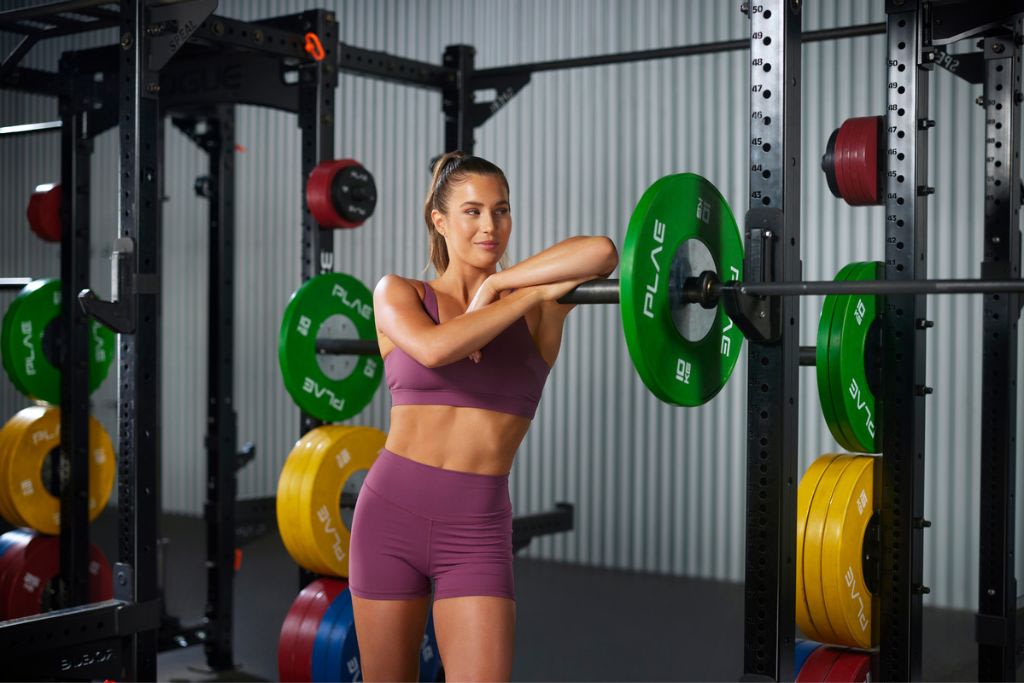How Much Weight Should You Lift? Katie Martin Explains

February 15, 2023

The Sweat Community has been LOVING Katie Martin’s Strength & Sculpt program since the day it first landed in the Sweat app (so much so that she immediately whipped up the second six-week block to keep you going on your strength journey!), but there’s one question that has popped up again and again.
How much weight should I lift?
We took the question straight to Katie to get all the answers you’re after to keep killing it in your training.
Katie, how much weight should people be lifting when following your Strength & Sculpt program?
To reap the most benefits from Strength & Sculpt you ideally want to be training in a style known as hypertrophy. When completing hypertrophy training you want to be lifting 8-12 reps at roughly 70% of your 1RM or one rep max - the heaviest you can lift for a single rep.
This can vary from person to person and exercise to exercise, so it’s important to use this as a guideline rather than a definite. This is why you will see that this is the set rep range for the majority (but not all) of the workouts. Again, this is also intentional to keep your body challenged and try to avoid plateaus!
For example, if your 1RM for a back squat is 100 kg, lifting at 70% of your 1RM would mean doing your set reps at around 70 kg. Like I said, this will vary person to person and exercise to exercise as we are not all the same and different exercises require different muscles.
If you are unsure what your 1RM of an exercise is, just select a weight that feels as though you are working at a perceived level of 70% exertion. For me this is usually a weight where I would complete my set and feel about 2-3 reps away from failure, where you’re unable to complete another rep.
As you progress through Strength and Sculpt you may feel as though you are making progress and getting stronger - this is to be expected and celebrated! What may have felt like a 70% exertion level in week one may feel like a 50% exertion level by week three. At this stage it would be time to increase the weight you’re lifting so you continue to be at that 70% exertion level. This way of training and progressing is known as progressive overload.
Progressive overload is all about increasing your reps, weights, sets and overall volume of your training to maintain a perceived level of exertion - but you don’t usually increase all of these factors at the same time.
Increasing these elements of your program will ensure you are applying the same amount of ‘stress’ to your body at all times in order to make continual progress - whether you’re wanting to get stronger, fitter or faster. Think about your fitness goals and make sure you’re following a Sweat program that aligns with them. With Strength & Sculpt the aim is to see your strength improve over the course of the 6+ weeks.
It is up to your discretion to identify when exercises are feeling too ‘easy’ and when it's time to increase your weight selection, but here are some indicators you might be lifting too much or not enough.
Signs your weights are too light:
You don’t require the set rest time
You’re finishing the workout substantially faster than previous weeks
You have a notable amount of energy left at the end of the workout
You’re having thoughts and an inkling that you want to pick up heavier weights
Signs your weights are too heavy:
You’re unable to complete set reps
You’re needing more time than suggested to complete the workout or more rest time than suggested
You’re unable to complete the exercise with proper form
You’re feeling the exercise in the wrong muscles
You’re not enjoying your workouts
You’re too sore and not recovering from the workout as you usually would
It’s important to remember that not all progress is linear and making strength gains every single week is not expected. Being consistent with your form and technique will go much further than increasing the weight to the detriment of the quality of your movement. Good form before anything else… ALWAYS!
You want to strive for the feeling of constantly being perfectly challenged. What I mean by this is ensuring you are pushing yourself enough that you’re properly adhering to the idea of progressive overload, but not so much that you resent doing the workout itself or are risking injuring yourself. I like to think of this like the Goldilocks theory - not too much, not too little, just right!
If you’ve got any other questions, feel free to pop them in the Sweat forum or message me on Instagram!
Like the sound of Katie’s training style? Strength & Sculpt is available exclusively in the Sweat app now - 12 weeks of strength training to help you feel stronger, fitter and more empowered with every workout.

A more empowered you starts with Sweat, and our editorial team is here to bring you the latest fitness tips, trainer recommendations, wellbeing news, nutritional advice, nourishing recipes and free workouts.
* Disclaimer: This blog post is not intended to replace the advice of a medical professional. The above information should not be used to diagnose, treat, or prevent any disease or medical condition. Please consult your doctor before making any changes to your diet, sleep methods, daily activity, or fitness routine. Sweat assumes no responsibility for any personal injury or damage sustained by any recommendations, opinions, or advice given in this article.
Fitness